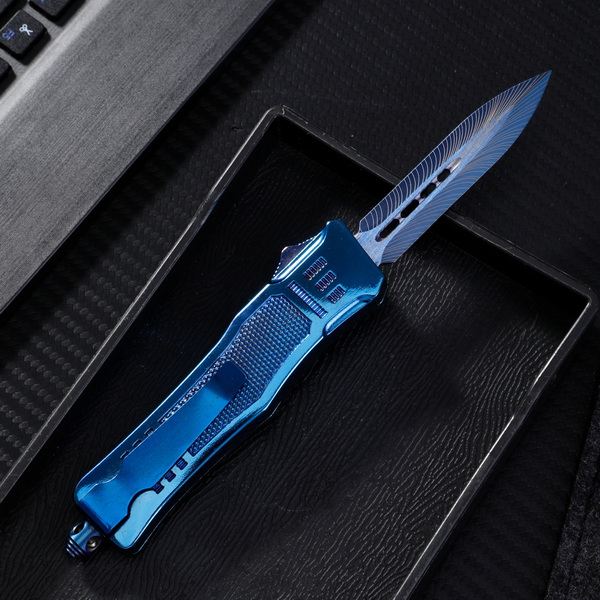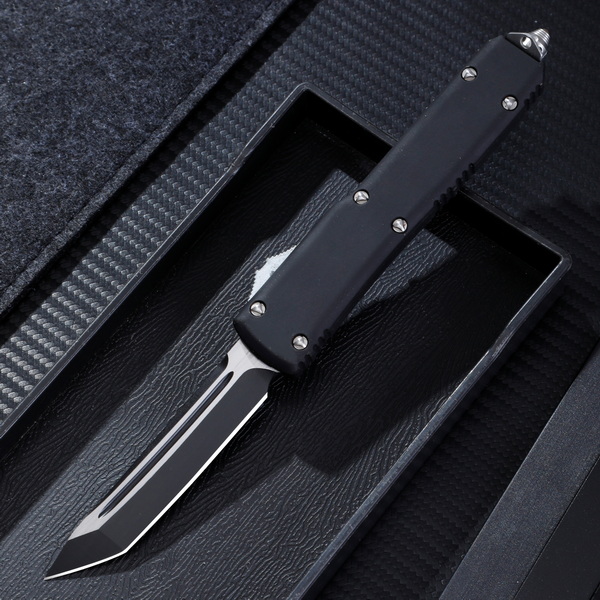Views: 222 Author: Leah Publish Time: 2025-11-03 Origin: Site











Content Menu
>> The mechanism and deployment
>> Variants and safety considerations
● The Professional Case for Tactical OTF Knives
>> Speed and field effectiveness
>> One-handed operation and ergonomics
>> Compact form factor with high utility
>> Comparison with other designs
● Materials and Engineering Trends in 2025
>> Blade steels and edge retention
>> Handles, liners, and ergonomics
>> Coatings and stealth considerations
● Market Dynamics and Adoption by Professionals
>> Regional legal considerations
● OEM Services and Collaboration
>> Production workflow (high level)
>> Quality control and compliance
>> IP protection and risk management
>> Value proposition for brands
● Practical Considerations for End-Users
>> Training and safe operation
● Case Studies and Applications
>> Case study A: emergency responders and rapid entry
>> Case study B: industrial technicians and utility work
>> Case study C: field professionals in harsh climates
● Regulatory Landscape and Global Compliance
>> Practical guidance for brands and manufacturers
● The Future of Tactical OTF Knives
>> Emerging actuation and smart integration
>> Sustainability and repairability
>> The continued role of OEM partnerships
● FAQ
>> 1. What is an OTF knife and how does it work in professional settings?
>> 2. Are Tactical OTF Knives legal in all countries?
>> 3. Why do brands choose OEM partners for Tactical OTF Knives?
>> 4. What materials are commonly used in high-end OTF blades?
>> 5. How should maintenance be performed on Tactical OTF Knives?
In high-stakes environments such as emergency response, field operations, industrial maintenance, and tactical training, the reliability and speed of a cutting tool can directly influence outcomes. Tactical OTF Knives (Out-The-Front knives) have emerged as a preferred solution for professionals who require rapid deployment, one-handed control, and compact carry. This article examines the core reasons behind their rising adoption, compares OTF designs with traditional folding and fixed blades, and explores how OEM manufacturers—especially those operating in China—partner with international brands to deliver high-precision production, stringent quality control, and scalable supply chains. The discussion also addresses practical considerations for end-users, regulatory landscapes across regions, and future directions for actuation technologies and materials. Throughout, the emphasis remains on performance, safety, and the realities of professional use.

An OTF knife houses the blade inside the handle and deploys it automatically through a switch or lever. When activated, the blade exits through the front of the handle in a smooth, straight line, enabling rapid single-handed operation. This core capability—near-instantaneous deployment—makes Tactical OTF Knives highly valued in time-sensitive tasks where every second matters. The design combines a compact silhouette with a robust blade geometry, optimized for a range of professional duties from cutting seat belts to breaching barriers. These features drive demand from brand owners and OEM partners seeking repeatable performance across large production runs.
The landscape includes dual-action mechanisms that deploy and retract with a single control, plus variants designed to meet regional legal requirements around automatic knives. Some professionals prefer safer, non-automatic options where permissible, prioritizing controlled deployment and reduced risk of inadvertent activation. For OEM collaborations, maintaining precise tolerances in the deployment axis, blade stop, and lockup is critical to ensure consistent performance across thousands of units.
High-performance blade steels, corrosion-resistant coatings, and durable handle materials (such as aluminum alloys, G-10, and reinforced polymers) are common in Tactical OTF Knives. Surface treatments—like PVD or DLC coatings—enhance wear resistance and reduce reflectivity in sensitive environments. For branding and end-user perception, grip geometry and tactile feedback are designed to remain consistent even under wet, dusty, or gloved conditions.
For contract manufacturers, the key takeaways are repeatable machining tolerances, reliable heat treatment, and traceable component sourcing. Meeting stringent QC standards ensures that every unit—from the first prototype to mass-produced units—delivers identical feel, deployment speed, and blade retention under field conditions.
The most cited advantage is deployment speed. With a deliberate press or switch action, the blade is ready for immediate use, which can be decisive in emergency or tactical scenarios. This speed translates into improved operational tempo, reduced cognitive load during critical moments, and enhanced effectiveness in tasks such as cutting through restraints, membrane material, or rope during rescue operations.
Professionals often operate with gear in both hands or gloves on. The ability to deploy the blade with one hand while maintaining control of the other tools or stabilizing a scene offers clear advantages. Ergonomic handle profiles, textured surfaces, and balanced weight distribution contribute to reduced hand fatigue during extended use.
The compact footprint of most Tactical OTF Knives allows easy concealment or discrete carry while still delivering a full-sized blade when deployed. This combination of portability and capability suits professionals who must move swiftly through tight spaces or crowded environments without sacrificing cutting performance.
Today's Tactical OTF Knives use corrosion-resistant steels, strong locking mechanisms, and robust internal designs that resist dust and moisture intrusion. For professionals in challenging climates, these characteristics translate to longer service life, fewer maintenance interruptions, and more predictable performance in the field.
While traditional folding knives require manual opening and can suffer from blade play or jammed mechanisms in dirty conditions, high-quality OTF designs are engineered to minimize such issues with hardened rails, precision springs, and sealed housings. OEM partners emphasize durability, controlled deployment force, and consistent retration performance, which informs marketing strategies and after-sales support plans.

Modern Tactical OTF Knives leverage premium steels with high wear resistance and corrosion resistance, balancing sharpened edges with toughness to withstand real-world tasks. Heat treatment profiles are optimized to ensure consistent performance across batches, a critical factor for OEMs supplying multiple brands.
The handle is equally important as the blade. Engineers focus on grip texture, contouring, and finger guards that offer secure handling in wet or gloved conditions. Materials such as aluminum alloys or reinforced polymers provide a combination of strength, lightness, and cost efficiency for large-scale production.
Coatings reduce wear from contact with abrasive materials and minimize reflection in sensitive environments. DLC and other PVD-based finishes are common choices that offer durability and low visibility.
Precision milling, lubrication strategies, and robust sealing techniques minimize play and misalignment. Ongoing QC checks—such as torque testing, drop tests, and automated deployment speed measurements—ensure consistency across thousands of units in a single production run.
Regional rules governing automatic knife mechanisms influence design choices. Some markets require non-automatic deployment or specific safety features. OEMs must maintain flexibility in design variants to satisfy diverse regulatory landscapes while preserving core performance traits.
Speed, one-handed operation, improved ergonomics, and rugged reliability drive broad adoption in professional segments. As brands expand into outdoor, rescue, and industrial service markets, Tactical OTF Knives become a standard part of professional toolkits.
Emergency responders, search-and-rescue teams, field technicians, and tactical operators represent core user groups. Each segment values deployment speed, reliability, and compatibility with their equipment and PPE.
Knife laws vary widely by country and subregion. Understanding these constraints helps OEMs design with compliant variants and provide accurate guidance to distributors and end-users.
OEM partnerships often involve co-branding, private label arrangements, and tiered support structures to accommodate brand expectations around warranties, replacement parts, and training.
Design customization (blade geometry, coating, and handle material), materials sourcing, precision machining, assembly, quality control, packaging, and after-sales service. The value lies in consistent quality, supply chain resilience, and rapid scale.
From concept to mass production: design iteration, prototyping, CNC machining, heat treatment, blade grinding, assembly, QC, packaging, and distribution. Robust traceability systems ensure batch-level quality auditing and compliance.
OEMs must align with international standards for safety, labeling, and documentation, while also accommodating brand-specific QA criteria. This reduces field returns and supports a stronger brand reputation for reliability.
Clear non-disclosure agreements and controlled access to design files are essential when partnering with overseas manufacturers. Good contracts define ownership, revisions, and allowed use of proprietary tooling.
Faster time-to-market, consistent performance, scalable production capacity, and access to advanced material systems and finishing processes that would be difficult to develop in-house.
Comprehensive user training improves deployment speed and safety. Practical drills focusing on one-handed operation, safe retraction, and handling in PPE help reduce accidents and operator error.
Regular cleaning of deployment mechanisms, lubrication of moving components, inspection for blade play, and adherence to manufacturer maintenance intervals maximize reliability and lifespan.
Professionals must stay compliant with local regulations and use Tactical OTF Knives responsibly, particularly in environments with strict weapon policies.
Offering robust warranties, a reliable spare-parts supply chain, and accessible service centers is essential for brand trust in professional markets.
In high-pressure rescue scenarios, the quick deployment and reliable edge of a Tactical OTF Knives model enable responders to cut seat belts, clothing, or tarps rapidly without sacrificing safety.
Technicians use the knives for cable management, packaging, and field repairs. The rugged build withstands dirty environments and repeated use, supporting uptime in critical maintenance windows.
Harsh weather and extreme temperatures test edge retention and corrosion resistance. OTF designs with appropriate coatings and metallurgy demonstrate consistent performance in these conditions.
Training, maintenance, and supply chain support are as important as blade performance. The collaboration between brands and OEM partners determines how well field teams can rely on Tactical OTF Knives.
Laws differ widely on automatic opening mechanisms and blade length. Understanding local requirements helps design compliant models and educate distributors about permissible configurations.
Build safety features that meet or exceed local standards, provide clear labeling, and maintain documentation for international sales.
Work with experienced OEMs who understand cross-border sourcing, component traceability, and the regulatory nuances of each market segment. This minimizes compliance risk and accelerates market entry.
The next wave includes refined actuation mechanisms, improved deployment precision, and potential integration with sensors or digital features that assist with maintenance tracking and deployment diagnostics.
Increasing emphasis on repairability, modular components, and recyclable materials aligns with broader sustainability goals in manufacturing and consumer markets.
Scalable production, consistent QC, and global supply networks will remain central to delivering high-quality Tactical OTF Knives at enterprise scale. For brands, maintaining strong OEM relationships translates into faster new product cycles and reliable regional support.
Tactical OTF Knives continue to gain traction among professionals due to their speed, one-handed deployment, and robust design. For OEM manufacturers, this growth creates opportunities to collaborate with international brands on high-precision production, material optimization, and rigorous quality control. By emphasizing training, safety, and regulatory compliance, brands can leverage the strengths of Tactical OTF Knives while ensuring reliability in demanding field conditions. The combination of professional performance, compliant design, and scalable manufacturing defines the modern path to success for OEM partners in the outdoor and tactical tool space.

- An OTF knife deploys its blade automatically from the handle with a switch or button, enabling rapid, single-handed operation that is valuable in time-critical professional tasks.
- Legality varies by region; some jurisdictions regulate or restrict automatic deployment knives. Always verify local laws before procurement or use and design products to comply where required.
- OEM partners provide design customization, controlled manufacturing, and consistent quality across large-volume orders, enabling brands to scale while maintaining performance and safety standards.
- Premium OTF blades often use high-performance steels with corrosion resistance and edge retention, complemented by durable handle materials and protective coatings.
- Regular maintenance includes cleaning the mechanism, lubricating moving parts, inspecting for blade play, and following the manufacturer's guidelines to preserve deployment reliability.
[1](https://bladeops.com/blog/pros-and-cons-of-otf-knives-for-tactical-operations/)
[2](https://ravencresttactical.com/otf-tactical-knives-advantages-and-uses/)
[3](https://bladeops.com/blog/the-advantages-and-disadvantages-of-otf-knives-in-tactical-settings/)
[4](https://knife-depot.com/blogs/sharpened-values/otf-knives-explained-the-complete-guide)
[5](https://leeknives.com/what-is-an-otf-knife/)
[6](https://www.tacticalsportinggoods.com/blogs/news/ultimate-guide-to-the-top-10-otf-knives-of-2025-features-reviews-and-recommendations)
[7](http://valentinoyoga.com/2024/06/27/the-benefits-of-otf-knives/)
[8](https://www.58hrcknives.com/what-makes-an-otf-knife-tactical.html)
Tactical OTF Knives vs Automatic Knives: What You Need to Know
How Tactical OTF Knives Enhance Outdoor and Survival Performance
Why Tactical OTF Knives Are Gaining Popularity Among Professionals
Tactical OTF Knives vs Folding Knives: Key Performance Comparisons
Tactical OTF Knives vs Fixed Blade: Which Is Better for Outdoor Survival